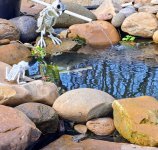I unfortunately do not have experience with frog ponds, but I know a fair amount about frogs.
Here are some characteristics of a pond that attracts frogs.
Ponds designed for frogs, unlike fish ponds, must have very easy access to both the land and the water. Otherwise the frogs will view them more as pitfall traps than ideal habitats. If your pond does not have shallow edges, then add lots of plants, rocks, or logs along the edges so the frogs can easily get in and out.
Avoid disturbing the water too much. If you install a squirting frog, be sure that the pond has a calmer side where the water is not too agitated. The squirting frog should be enough to prevent low oxygen levels as long as there are no fish in the pond.
Keep dogs and cats away from the pond as these animals are terrifying to frogs.
Most algae are harmless for frogs. Tadpoles actually need some algae in the pond since they feed on it. Adding aquatic plants to the pond should help keep the algae from overpopulating to the point of causing harm.
Floating plants like water lilies should help keep the pond from overheating by shading the bottom. Surrounding the pond with tall marginal plants like sedges might also provide some shelter from the sun. If they are not enough, then you may have to install some kind of gazebo to shade the pond. Maybe a temporary shade would be better, since aquatic plants need sun.
On land you can provide some moist, shady areas to protect the frogs as well.
Yes, frogs, toads, and salamanders love leaf litter, especially when it is moist.
Frogs mostly travel from pond to pond when it rains, but without leaf litter, logs, rocks, and moist soil, they will perish once everything dries out and the sun shines again. This decreases their chances of finding your pond.
Chemicals like herbicides and pesticides often kill frogs. Even harmless pesticides like diatomaceous earth should be used in moderation, since they kill the insects that the frogs eat.
Hope this helps!


